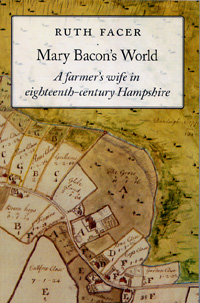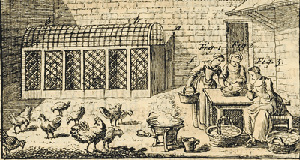 I’ve been reading Mary Bacon’s World by Ruth Facer, a detailed look at the life of a farmer’s wife in 18th century Hampshire, taken from her personal ledger, which contained much more than financial entries. It’s a personal journal in which she has recorded many aspects of her life; truly an historians dream of source material.
I’ve been reading Mary Bacon’s World by Ruth Facer, a detailed look at the life of a farmer’s wife in 18th century Hampshire, taken from her personal ledger, which contained much more than financial entries. It’s a personal journal in which she has recorded many aspects of her life; truly an historians dream of source material.
Like those of many women of her generation, her journal includes things like recipes and the minutiae of farm life, all of which are interesting to anyone writing about the period. For example, when she and her new husband moved to their home at Aylesfield Farm, she meticulously recorded the expenses for needed repairs, including holdfasts (probably some sort of clamp or staple), brushes, Linseed oil, nayls (and also nails). In total they spent £43 15s. Quite a lot to get the farm in order, not mention chips, 5 cord of Grub wood (roots or branches lying on the ground). This was, probably for heating. She also includes a furniture inventory which indicates a level of prosperity for the new couple.
Her ledger also includes a detailed picture of the life of a farmer’s wife, including stock, the weather, the care of animals, and cures for people living in or around the farm.
Mary seemed to rely on Culpeper’s Complete Herbal and English Physician for caring for her livestock. For example, to cure a bovine urinary tract infection:
Take a handfull of Hot Dung, half a pint of Rennet half a pint of Brine and a handful of mustard Seed Bruised Simmer it together and Give it to the Cow and let her Stand two hours without meat If one Drink fails Stop one Day & Give her another in the morning.
Sort of makes you glad you’re not her cow. She has equally interesting cures for human ailment, including piles, constipation, dental problems, and epilepsy.
Mary’s kitchen inventory gives a good picture of how she cooked and her ledger contains recipes, many copied from Hannah Glasse’s First Catch Your Hare, The Art of Cookery Made Plain and Easy, but also some of her own and those from her friends.
From the ledger, we also learn a lot about Mary’s reading material, including Almanacs, chapbooks, and newspapers. Among the things she copied out in her journal was a table of information about the West Indies (including, the length and breadth of each island, it’s principal towns and which country owned it) , in which she was apparently interested.
Her ledger includes her extensive book list. This includes, as well as Culpeper’s Herbal, many religious books, The Universal Parish Officer (containing the laws in force pertaining to parish business), The Gentleman’s Jocky & approved farrier, and a history of England.
I could go on. There is an incredible amount of useful material in this book, if you’re interested in the life of an intelligent and fairly prosperous farmer’s wife during the late 18th and early 19th century. I highly recommend it.


Sigh. Yet another book for me to covet. I don’t know if I should thank you or not.
I love firsthand references like this one; they include tidbits that are frequently ignored by history books but are so useful to fiction writers. Putting it on my list…
I’ll definitely have to look this one up. I always love old recipes and medicines…
The TBR stack just groaned! What a great resource! All of those little everyday tidbits are what make for a great read.